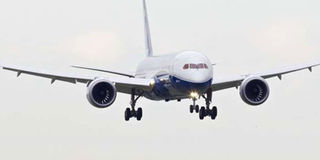WORLD OF FIGURES: Working out the fuel consumption rate of aeroplanes

The Boeing 787-8 Dreamliner is one of the most fuel-efficient commercial jets, consuming about 5.5kg/km. PHOTO | FILE | AFP
What you need to know:
- There was an aircraft that crashed several years ago because it ran out of fuel.
- The problem was that the pilot ordered fuel in kilogrammes but the ground crew were using a filling machine that dispensed in litres.
- Instead of working out the conversion correctly, the technicians assumed that one litre is equal to one kilogramme.
- The plane got 15% less fuel than required so it couldn’t complete its journey!
Shadrack Mwangi says that a newspaper story about the first by Kenya Airways (KQ) direct flight to the USA claimed that the aeroplane would carry 85 tonnes of fuel.
In another paragraph, the writer wrote 85,000 litres. So, Shadrack wondered: is one kilogramme of jet fuel equal to one litre?
The answer is no. Water is the only substance I think of; which one litre is one kilogramme. In the case of jet fuel, one litre is about 840g, or 0.84kg. This is the reason why it floats on water.
Therefore, 85,000 litres of jet fuel weigh 71,400kg, or 71.4 tonnes. On the other hand, the 85 tonnes are equal to 101,000 litres.
Now this is a significant difference. Indeed, there was an aircraft that crashed several years ago because it ran out of fuel.
The problem was that the pilot ordered fuel in kilogrammes but the ground crew were using a filling machine that dispensed in litres. Instead of working out the conversion correctly, the technicians assumed that one litre is equal to one kilogramme. The plane got 15% less fuel than required so it couldn’t complete its journey!
Now you might wonder why the pilot didn’t just fill it up to the brim. The reason is that aeroplanes have very large fuel tanks. If it is filled up for a short journey, it ends up carrying a lot of deadweight — and wasting fuel.
FUEL EFFICIENT
The Boeing 787-8 Dreamliner used by KQ on the Nairobi-New York service has a tank capacity of 127,000 litres, that is, 106 tonnes. It is one of the most fuel-efficient commercial jets, consuming about 5.5kg/km.
So, on the 12,000km journey from Nairobi to New York, it will need about 5.5 x 12,000 = 66,000kg or 66 tonnes of fuel. To be on the safe side, the pilots add another 19 tonnes to make a total of 85 tonnes.
An interesting comparison might be made between the aeroplane and a family car. 5.5kg/km is equal to 6.55L/km.
An average family car easily does 15km/L on the highway. This is equivalent to 0.067L/km. It seems that the car is about 100 times more efficient than the aeroplane: but is it?
The aeroplane carries 234 passengers, excluding the crew. So, its consumption per passenger is 0.027L/km. The car takes four people excluding the driver. Thus, it consumes 0.017L/km.
Even though the car is more fuel efficient, the difference is not so big. And considering that the car cruises at just 100km/h while the aeroplane does 1,000km/h, I think the little extra fuel is worth it.
***
On a related matter; I was shocked to learn that there are people out there who still think that a bus doing 100km/h is faster than a car also at 100km/h. They say that this has to do with the size of the wheels.
If you come across such a person, ask them this: Since an aeroplane does not fly on wheels, does that mean that it has no speed?
www.figures.co.ke; Twitter: @MungaiKihanya




